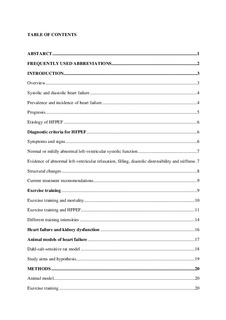| dc.description.abstract | Heart failure with preserved ejection fraction (HFPEF) is the only cardiovascular disease with an increasing incidence and prevalence. Complex pathophysiology of the disease and multi-organ involvement confers with high mortality rates among patients. Despite rising prevalence and poor survival prognosis, there are no established treatments up to date to improve clinical outcomes. Exercise training is recommended to improve functional capacity and the quality of life in patients and could possibly outweigh any pharmacological intervention, since lifestyle dependent risk factors, physical inactivity and deconditioning contribute to the deterioration of HFPEF. However, the optimal dose of exercise, exerting beneficial effects on cardiac and renal function and structure is not yet established and require further evaluation in experimental studies. Methods: Female Dahl saltsensitive (DS) rats were randomized into sedentary low-salt (LS), high-salt (HS) and three exercise training groups. The rats performed moderate intensity continuous treadmill running (MCT), 5-times 40 min/week at 60 % of maximal oxygen consumption (VO2max); high intensity interval training highvolume (HIT-HV), 3-times/week, 4 intervals of 4 min at 90 % VO2max, separated by 3 min at 60 % VO2max and high intensity interval training low-volume (HIT), 2 intervals of 4 min at 90 % VO2max, separated by 3 min at 60 % VO2max. Total distance run was given as a measure of running performance. Blood pressure (BP), echocardiographic evaluation of diastolic function and cardiac structure, hemodynamic measurements and blood analysis were performed. Body organs were harvested, tissue weights measured and subjected to histological analysis. Metabolic cages were used to collect urine samples and evaluate kidney function. Lastly, survival distribution was estimated using the KaplanMeier method. Results: All of the rats placed on high sodium diet (8.0 % NaCl), developed hypertensive BP levels, diastolic dysfunction and left-ventricular concentric hypertrophy, while ejection fraction remained normal. The levels of NT-proBNP were elevated and a mild kidney dysfunction developed. Exercise training did not lower BP and did not improve pathological changes in cardiac and renal function and structure. The mortality rates were not different between high sodiumgroups and the animals were prematurely dying from stroke at a high rate. Conclusion: Female DS rats placed on a high sodium diet, satisfied the clinical HFPEF diagnostic criteria and progressed into HF at week 35. Development of diastolic dysfunction was consistent with progressing decline in renal function. Although exercise did not alter the overall mortality observed in DS rats under high sodiumintake, exercise trained groups had a modest delay in mortality compare to HS animals and HIT-HV and HIT-LV showed better estimated survival at the end of the study. The study clearly confirmed that stroke is the major cause of mortality in DS model and suggested that the high incidence of stroke might be related to the chronic high sodium intake. | nb_NO |
